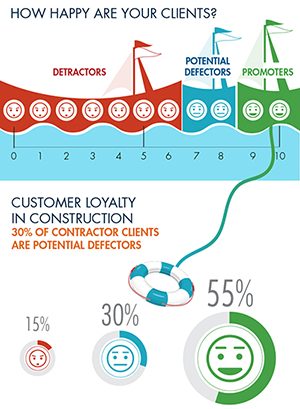Four Ways to Take Your Client Relationships to the Next Level

Customer loyalty is more than repeat business. Now is the time to recalibrate your client focus and achieve new levels of customer loyalty.
Sitting here in the third quarter of 2017, within a few months of the 10-year anniversary of the Great Recession, we are in a buoyant construction market. It is not just the major metropolitans that are “on fire.” The resurgence of activity across the nation is providing ample opportunities to any attentive contractor.
With this backdrop, the day-to-day focus is on grabbing market share and building a team that can execute on our commitments—certainly no easy task. So does this mean we can take our foot off the “strategic gas pedal”? After all, where can we find the time to think about the future when we are in the heat of today’s battle?
The truth is, leading organizations never stop thinking long term; they constantly challenge how they position to win, deliver value and succeed in their marketplaces. A lot has been written on this subject. Authors Michael Treacy and Fred Wiersma, in their book “The Discipline of Market Leaders,” describe three generic competitive strategies or value disciplines: operational excellence, customer intimacy and product leadership. Let’s think about how we can apply these principles in our industry.
Jack of All Trades, Master of None
With operational excellence, customer intimacy and product leadership all on the menu, the natural (optimistic) tendency is to declare an intent to win on all three, and all the time. While this intent is honorable, companies that do this usually come up short. The result is a jack of all trades, master of none. There are many examples of companies, both inside and outside of the industry, which have become leaders by being more focused, not less.
So where to focus? Product leadership means bringing customers leading-edge products and services that consistently enhance the customer’s use or application of the product, in turn making competitors’ goods obsolete. In our industry, it is increasingly difficult to stand out in this regard. Contract methods, delivery systems, procurement practices, means and methods, and so forth are easy to replicate once one competitor discovers a first-mover advantage. However, this should not preclude us from exploring innovations that could set us apart.
What about operational excellence? Some might even call this discipline “table stakes.” After all, if we cannot provide our clients with reliable service, at a competitive price, delivered efficiently with minimal headaches, then why are we even in business? In reality, we encounter companies daily that struggle to deliver operational excellence. The body of evidence is strong on this topic; too few contractors create the robust systems, tools and processes necessary to deliver on their promises. Look at how long it takes to punch out a project and how many items linger well after substantial completion.
That leaves us with customer intimacy. This is the good, old-fashioned “segment, target and position” approach, which is often taken for granted. The more we can understand our client base and then tailor offerings to match exactly the demands of those niches, the more successful we will become.
Companies that excel in this discipline understand how to balance detailed client knowledge with operational flexibility to respond to client needs.
Don’t Confuse Repeat Business With Customer Loyalty
Working with contractors around the country, we often hear that “80% of our business comes from repeat clients.” At first glance, this statistic would imply a strong level of customer commitment and loyalty. But we need to challenge ourselves below the headline by asking:
- Do those clients come back to us because we are their No. 1 choice?
- Or are we simply fulfilling their need to spread some work beyond their preferred contractors?
- Is it a capacity issue?
- Do they see us as a lower-quality option, able to satisfy their needs on a “C” project?
Exhibit 1. Customer Loyalty in Construction

Data Source: FMI Research Services
Statistics are based on more than 5,000
contractor-client responses.
This all may sound a bit negative, but we must be prepared to challenge conventional thinking at a time when industry capacity is stretched. My colleague Jay Bowman recently wrote about the importance of understanding your Net Promoter Score in the article “Three Ways to Keep Your Clients From Defecting to the Competition.” Jay underscored the importance of truly understanding how your client base feels about you, stating, “From FMI’s research, 30% of contractor clients could drop them at a moment’s notice,” as shown in Exhibit 1.
Losing those clients can be devastating, so how do you achieve customer intimacy, and how do you know when you get there? For starters, customer intimacy is something you earn through a commitment of your time, talent and treasure. Many companies pay lip service to this principle with throwaway statements like “Client service is our No. 1 goal,” or “The client comes first.” Posting such statements on the lunchroom wall does not constitute commitment. The solution lies in your management of the relationship, understanding and ability to meet the clients’ greater needs.
Four Strategies for Building Deeper Client Relationships
Client and work acquisition are team sports. Not everyone in your company has the responsibility of targeting and winning new customers, but everyone is responsible for making sure customers get the outcomes they hired your company to achieve, and with the least possible hassle. These comments are likely intuitive to most, if not all, of our readers. However, the application of these ideas is what sets contractors apart. An email from the desk of your company president, declaring “Everyone has a role to play in business development,” won’t cut it.
To achieve new levels of customer loyalty, conduct a concerted review of all your business development (work acquisition) activities through the integrated chain, namely marketing, sales and customer service. There are opportunities to earn customer loyalty in each of these areas. The real win comes when you can demonstrate an integrated approach where there is virtually no line of separation. In other words, clients perceive a “one-to-one” relationship at each stage regardless of which company representative they encounter. Do this by:
- Increasing the number of client touchpoints. Customers are organizations (public, private, for profit, not for profit) made up of individuals who can choose to either hire you or someone else. Some customers have the authority to say yes, but many more can say no. We need to increase the range and frequency of touchpoints to ensure we fully understand clients’ needs and filter them back to our organizations.
- Ensuring executive involvement. Too many executives gravitate to the operational side of the business. It is the area they have likely grown up in, and so they feel comfortable in those roles. Widening the focus beyond the immediate needs of the projects and building the right teams to run the day-to-day operations allow you to get out in front of developing one-to-one relationships and learn about your client’s business. This translates into better knowledge of future opportunities and a chance to differentiate your company.
- Developing a client-service culture. Companies with a strong, client-centric culture have greater success rolling out positive relationship behaviors to frontline employees and reaching those who can truly impact a client’s experience. Do you have a cadre of superintendents who will see a client from across the job site and run toward him or her, seeking feedback, providing observations and getting ahead of problems? Or do they run the other way in the hope they are not seen?
Cultural shifts do not happen overnight, nor do they happen by chance. Creating the right culture requires an investment in your people. Ask yourself questions like: Are we hiring the right people, and are they armed with the right tools, training and questions? Are they encouraged to get closer to the clients—not just during a project but also in between projects? Think of the cumulative impact you can achieve with 10 project managers regularly interfacing with just five key clients on an ongoing basis.
- Rewarding employees. Our industry is built on hard work and going beyond the call of duty, but how often are these cornerstones taken for granted by associates? Highly engaged employees who exhibit the right behaviors at any level should be rewarded accordingly. Formal or informal incentive programs and bonuses not only motivate employees but also get them more in tune with the company approach. Customer intimacy relies on increasing employee knowledge at every touchpoint.
Time, Focus and Effort
Customer intimacy is a discipline and must be much more than a marketing slogan to make an impact. True customer intimacy can only be earned by aligning all functions and layers of the organization around the needs of the individual customer. By promoting lifetime customer value and developing strategies to increase customer intimacy levels with a business, companies can position themselves to win in today’s highly competitive market—a mission that requires time, focus and organizational effort.



